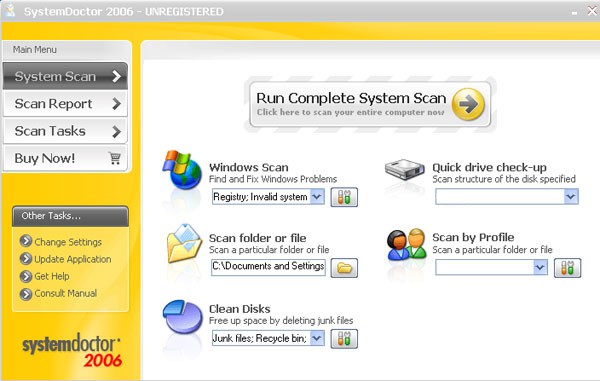SystemDoctor Removal Instructions
Why is it important to remove SystemDoctor?
SystemDoctor is an illegal and corrupt anti-spyware program!
SystemDoctor may look like a legitimate anti-spyware, but it’s created only to scare you into purchasing SystemDoctor. SystemDoctor may scare you into buying it by overwhelming you with fake alerts or pop-ups. SystemDoctor can’t prevent your computer from being infected with spyware — SystemDoctor may actually damage your system.
SystemDoctor is part of a group of rogue anti-spyware applications which falsely report spyware infections, then offer to remove the alleged spyware for a fee. Rogue anti-spyware applications similar to SystemDoctor include SpywareQuake.
I have SystemDoctor, what do I do?
You have many options for detecting and removing SystemDoctor. The most extreme is reformatting your PC, possibly costing you all of your data and definitely costing hour of time wasted on reloading your PC to its original form. Reformatting your computer should be your last resort. If you’re having problems finding SystemDoctor, try using a preferred spyware scanner to quickly detect SystemDoctor first. If you don’t have a spyware scanner, you can always try the instructional methods provided below.
- Start a full system scan to detect SystemDoctor & other parasites.
- SpyHunter will automatically search for SystemDoctor files.
Please note that SpyHunter’s free scanner is only for detection purposes. If SpyHunter’s scanner finds SystemDoctor on your PC, you can buy SpyHunter’s full version to remove SystemDoctor and other spyware.
Are you infected with SystemDoctor?
Your machine may be infected with SystemDoctor, if you have the following symptoms:
*Note: Symptoms tend to vary depending on software installed on your system and other system factors.
Symptom #1: A questionable red or green icon appears in your system tray next to the system clock, representing a newly installed program which you do not recall ever downloading. If you click on the icon a fake system alert popup will direct you to SystemDoctor’s website. In some cases, even when you don’t click on the icon the fake system alert may still pop up.
Symptom #2: The questionable icon pops up a fake system alert that lures you into downloading SystemDoctor program by stating that your computer is infected with dangerous spyware and that you should download SystemDoctor program to remove the alleged infection. The false system alert may read:
“System detected virus activities. They may cause critical system failure. Please, use antimalware software to clean and protect your system from parasite programs. Click this balloon to get all available software.”
Symptom #3: Once you’re infected, rogue anti-spyware SystemDoctor will run on every time Windows starts up. A screenshot of SystemDoctor is provided below.
SystemDoctor Manual Detection
If you’ve discovered that SystemDoctor has infected your PC, you must act quickly and take the proper steps to eliminating the infection. Note: The manual removal of any parasite is difficult. To avoid the unnecessary risk of damaging your computer, we advise you to download SpyHunter’s spyware scanner tool to automatically detect SystemDoctor.
To manually remove SystemDoctor, follow these removal steps:
Step #1: Remove SystemDoctor with Windows Add/Remove Programs utility.
Sometimes all it takes to get rid of spyware like SystemDoctor is to remove the program using the Add/Remove Programs control panel in Windows.
- In Windows XP Professional, click on Start > Control Panel > Add/Remove Programs
- In Windows 2000 Professional / Windows ME / Windows 98, click on Start > Settings > Control Panel > Add/Remove Programs.
- In the list of programs, search for the software you want to remove. If you see a program you don’t recognize or don’t recall installing, look it up in Google to learn what it is.
- Select the questionable program and remove it with the Remove button.
Step #2: Kill SystemDoctor using the Windows Task Manager
To kill a SystemDoctor process that has infected your computer, you will need to use the Windows Task Manager to check by process, highlight the process in question, and then end the task. To do this:
- Press CTRL+ALT+DEL or CTRL+SHIFT+ESC on the keyboard.
- Click on Processes Tab to see all active tasks. For easier detection, left click the process under the heading Image Name.
- Find and kill the following SystemDoctor process:
dcmon.exe
systemdoc.exe
DNSE.exe
dcpasmon.exe
SystemDoctor2006FreeBHInstall[1].exe
sdmain.exe
unins000.exe
systemdoctorfreesetup.exe
systemdoctor2006freeinstall.exe
sd2006.exe - Once you’ve identified the SystemDoctor process, press DEL on your keyboard or click End Process to kill it from your system.
Step #3: Use PsKill to Kill a Process
Sometimes a parasite can disable your Windows Task Manager so you can use pslist and pskill (a third party application by Mark Russinovich) to list and kill the unwanted processes.
- Download PsKill or PsList.
- Extract the program from the .Zip archive.
- Move pskill.exe to your C: drive.
- Open a command window and click Start > Run.
- Type cmd and click the OK button.
- In the command window, type C:pskill.exe and the name of the process you wish to kill, then press Enter. For example, if you wanted to kill the process for SystemDoctor, you would type: C:pskill.exe SystemDoctor.exe.
If the file was successfully removed, PsKill will say “process SystemDoctor.exe killed”. - Find and Remove these SystemDoctor files:
dcmon.exe
systemdoc.exe
SystemDoctor.url
Uninstall SystemDoctor.lnk
SystemDoctor.lnk
SystemDoctor on the Web.lnk
DNSE.exe
dcpasmon.exe
SystemDoctor2006FreeBHInstall[1].exe
SystemDoctor Free
sdmain.exe
uninstall systemdoctor 2006.lnk
unins000.exe
unins000.dat
umain.xml
systemdoctorfreesetup.exe
systemdoctor2006freeinstall.exe
systemdoctor 2006.lnk
systemdoctor 2006 on the web.lnk
sd2006url.url
Arraysd2006.exeArray

Leave a Reply
Please note that we are not able to assist with billing and support issues regarding SpyHunter or other products. If you're having issues with SpyHunter, please get in touch with SpyHunter customer support through your SpyHunter . If you have SpyHunter billing questions, we recommend you check the Billing FAQ. For general suggestions or feedback, contact us.